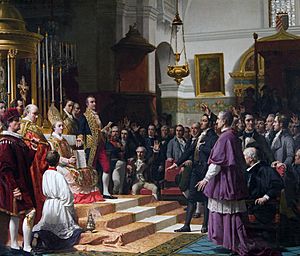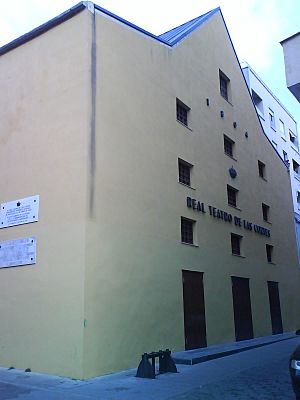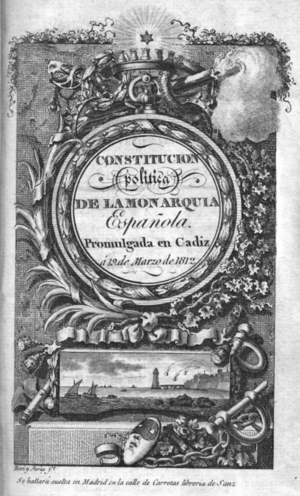Cortes of Cádiz facts for kids
The Cortes of Cádiz was a special Spanish parliament that met during a very difficult time for Spain. It was a new version of the old Spanish parliament, but it worked differently. Instead of being divided into separate groups, everyone met together.
This important meeting started on September 24, 1810, in the port city of Cádiz. It happened because France had invaded Spain during the Napoleonic Wars. The Spanish king, Ferdinand VII, and his father, Charles IV, had both given up their thrones. The Cortes of Cádiz claimed to be the only true representative of the Spanish people.
The Cortes included members from all over the Spanish Empire. This meant not just Spain, but also Spanish America and the Philippines. Many people, both then and now, see the Cortes of Cádiz as a big step towards liberalism (new ideas about freedom and rights) and democracy in Spain and Spanish America. The Cortes created and approved the Spanish Constitution of 1812. This constitution set up a constitutional monarchy, where the king's power was limited by a constitution. It also removed many old rules that gave special advantages to certain groups.
Contents
Why the Cortes Met: A Look Back
Napoleon's Invasion of Spain
In 1807, the French armies led by Napoleon invaded Portugal. Then, in 1808, they invaded Spain. This caused big problems for the Spanish royal family. King Charles IV and his son, Ferdinand VII, were already arguing a lot.
In March 1808, Charles IV was forced to give up his throne. With French soldiers in the capital city of Madrid, Napoleon saw a chance to take over Spain. He tricked both Ferdinand VII and Charles IV into coming to Bayonne, France. There, he forced them to give up their claims to the Spanish throne.
Napoleon then made his older brother, Joseph Napoleon, the new King of Spain in July 1808. Napoleon thought the Spanish people would welcome these changes. But instead, most Spaniards stayed loyal to their old king, Ferdinand VII.
Fighting Back: The Juntas
The Spanish people started to fight back against the French invasion. Local groups called juntas formed all over Spain. These were like local governments that opposed the French. They were made up of army leaders, guerrilla fighters, or local citizens.
These local juntas soon realized they needed to work together. They formed a larger group called the Supreme Central Junta in September 1808. This Junta acted as the government while the king was away. It decided to call a special meeting, an "Extraordinary and General Cortes of the Spanish Nation." This Cortes would be a law-making body for the entire empire. It would also write a new constitution for Spain.
By early 1810, the Spanish forces faced big defeats against the French. The French took control of southern Spain. This forced the Supreme Central Junta to move to Cádiz. Cádiz was a port city and the last safe place on Spanish soil.
Calling the Cortes: Who Came?
Setting Up the Meeting
On January 29, 1810, the Supreme Central Junta ended its work. It set up a group of five people called the Regency. This Regency was in charge of calling the Cortes. They made a list of Spanish people born in America who were already in Spain. These people could become temporary representatives.
Some parts of Spanish America had already started their own local governments. These areas did not recognize the Regency's authority. So, they did not send representatives to Cádiz. However, many other regions in America did send people. The Regency decided it was important to have some American representatives, even if the process was difficult.
Representatives from Across the Empire
The Regency set up rules for electing delegates. They decided that 30 representatives would come from Spanish America and the Philippines. For example, New Spain (which included much of modern-day Mexico) was given 7 temporary representatives. People had to be at least 25 years old and from the area they represented. Only men were allowed to be delegates.
When the Cortes first met on September 24, 1810, 104 deputies were there. Thirty of these were temporary delegates from overseas territories who were living in Spain. Eventually, about 300 deputies took part. This included 63 from Spanish America. The Cortes of Cádiz had a mix of people: about one-third were priests, one-sixth were nobles, and the rest were from the "third estate" (the middle class).
What Influenced the Cortes?
Cádiz's Location and Trade
The Cortes met in Cádiz, which was Spain's most important port for trade with the Americas. This meant that powerful merchant groups in Cádiz had a lot of influence. They wanted to keep their special trading advantages. People from the Americas, however, wanted freer trade.
During this time, there was pressure in Cádiz to send Spanish troops to stop rebellions in Spanish America. This worried Great Britain, which was Spain's ally against the French. Britain usually supported open trade in Spanish America. But during the war, Britain wanted all available troops to fight the French in Spain. So, Britain did not support Spain's efforts to stop the American rebellions.
Ideas for a New Government
Gaspar Melchor de Jovellanos, a former minister, believed a general Cortes should be called. He looked back at Spanish history for ideas on how a government should work. He thought the Cortes should not completely change Spain's old ways. He worried that too many changes could lead to problems like too much democracy or a ruler with too much power. However, he did believe that the government should have separate branches: one for making laws, one for carrying them out, and one for judging. He also thought there should be two parts to the law-making body, with an upper house for nobles.
Joseph Blanco White, a writer from Seville, also had a big influence. He started a magazine in London called El Español. This magazine was supported by the British government and was very popular in Spanish America. Its goal was to help the Cortes create a fair constitution. It also aimed to help Spain and the rebelling groups in America make peace. Blanco White supported the Americans. He published letters from important figures who wanted open trade, which would end Spain's trade monopoly.
New Laws and the Constitution
In its very first meeting, the Cortes declared that it, not the king, held the power of the nation. This was because the Cortes represented the people. Then, the assembly divided the government into three parts: one for making laws (legislative), one for carrying out laws (executive), and one for judging (judiciary). Since King Ferdinand VII was not there, the Regency acted as the executive branch.
The Cortes worked on changing the government while Spain was still at war. The delegates split into two main groups: liberals and conservatives. Conservatives saw the Cortes as a temporary solution until King Ferdinand VII could return. Most conservatives did not believe a parliament could make laws without a king.
The liberals, however, wanted big changes. They believed in ideas from the French Revolution. They wanted everyone to be equal under the law. They also wanted a strong central government, a good civil service, and fair taxes. They wanted to replace old feudal rules with freedom of contract and protect property rights. Since the liberals were the majority, they were able to turn the Cortes into a group that would write a new constitution.
The Spanish Constitution of 1812
The work of the Cortes showed that the liberals were in charge. The Spanish Constitution of 1812 became a very important document for liberalism. During the 1800s, it was used as a model for new constitutions in many Latin countries.
The constitution created a single state with the same laws across the entire Spanish Empire. Its main goal was to stop unfair and corrupt rule by the king. It set up a limited monarchy, where the king governed through ministers who were controlled by the parliament. The constitution said that the parliament would have one house and meet every year in the capital.
Voting rights were not based on how much property someone owned. This helped the commercial class (middle-class business people) in the new parliament. The constitution did not give special power to the Catholic Church or the nobility. It also created a new, efficient system of government based on new provinces and towns, rather than old historical borders. It removed old property rules, which helped create a freer economy. However, the 1812 Constitution did not give political rights or representation to people of African descent.
One interesting rule in the constitution was an early example of a seasonally adjusted schedule. This idea later led to daylight savings time about a century later.
What Happened Next?
King Ferdinand VII's Return
The Spanish Constitution of 1812 was a revolutionary document. It started Spain's tradition of liberalism. But when King Ferdinand VII returned to the throne in 1814, he refused to accept it. He closed down the Cortes on May 4 and ruled as an absolute monarch. These events led to a long conflict between liberals and traditionalists in Spain throughout the 1800s and early 1900s.
The Cortes of Cádiz had declared that the Spanish people held the power over all parts of the Spanish Monarchy, including the American kingdoms. It also said that the old system of separate kingdoms and provinces in Spain and the Americas was gone. Most of the Criollo people (people of Spanish descent born in the Americas) did not accept Spain's claims. They took power in their own American kingdoms, which had once been under the King of Spain.
Independence in the Americas
Spain's American colonies used the chaos after the war to declare their independence. Most of them set up republican governments. Many people in the colonies thought the new Spanish Constitution was too liberal. This only made them more determined to seek independence from Spain.
When Ferdinand was back on the throne in Madrid, he spent a lot of money and sent many soldiers to try and regain control of the colonies. But this effort failed. By the second half of 1826, only Cuba and Puerto Rico in the Americas remained under Spanish rule. The Philippines and Guam in Asia also remained Spanish.
See also
- Spanish Constitution of 1812
- Provincial deputation in Spanish America
- Spanish Empire
- Timeline of the Peninsular War
- Real Teatro de las Cortes
 In Spanish: Cortes de Cádiz para niños
In Spanish: Cortes de Cádiz para niños





